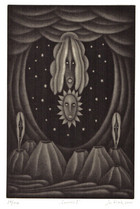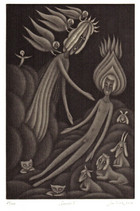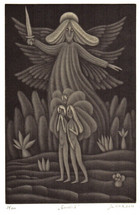Jan Hisek
(b. 1965)
Entering the imaginative world of Czech Graphic Artist Jan Hisek is like voyaging twenty thousand leagues under the sea. In his monochrome mezzotints, biomorphic shapes gleam against backgrounds of black, resembling phosphorescent sea creatures lured out of sunless ocean trenches. His numinous images of exotic plant life, fabulous birds, and hovering angels float into view like rudimentary archetypes from the murky depths of Carl Jung’s collective unconscious. They shape-shift into surreal scenes we recollect from myth and sacred story, often, narratives from the Bible like his print in the Collection of the Adoration of the Lamb from the Book of Revelation.
Hisek has described his singular artistic vision as “psychedelic romanticism.” His fascination with symbols and dreamscapes links him to the Tvrdohlavi (the Stubborn), a group of mythology-bending, post-modernist Czech artists active in the years leading up to the Velvet Revolution of 1989. They modeled themselves on the Trvdosijny (the Obstinate), a movement dating from the founding of the Czechoslovak Republic in 1918, whose members made symbol-laden works, often in a Cubist style, like Jan Zrzavy with his mystical Christ portraits. Hisek cites an eclectic trio of other artists as influences on his art-making: Hieronymus Bosch, Louise Bourgeois (famed for her spiders!) and Pablo Picasso.
The inspiration for Hisek’s flora and fauna comes from the artist’s father, Kvetoslav Hisek, an illustrator whose precisely-rendered drawings of wildlife and their habitats appear in dozens of popular science texts and bird-watching guides. Jan remains as obsessed with detail as the elder Hisek but left the natural world behind to create life forms in realms of the imagination. A graduate in 1990 of the Department of Book Illustration and Typography of the Prague Academy of Applied Arts, Hisek made his first images in this dreamlike style for editions of J.R.R. Tolkien’s faery tale, Smith of Wootton Major, and the Book of Revelation.
Christian motifs run through the artist’s work. The author of stream of consciousness texts, Hisek presents a straightforward account of the Life of Christ in The Day People saw the Comet, a prose poem that reads like a credo of faith. Hisek tells of the Christ who “called himself modestly just ‘Son of Man’ since He knew He came to this world with one purpose only: to die for his fellow men, to give them the supreme sacrifice, his own life.” The word becomes image in the artist’s mezzotint, Lambs, a variation on traditional depictions of the Good Shepherd, showing Christ as “the Lamb of God, which taketh away the sin of the world (John 1:29, KJV).”
Hisek relies on his viewers’ familiarity with the conventions of sacred art to suggest biblical identifications for the shadowy balloon-like shapes seen in the small format prints and book plates in the gallery. An illuminated figure kneeling in prayer beside three supine shapes among trees evokes Christ praying in the Garden of Gethsemane. A haloed form holding a child in the company of animals signals a Nativity scene just as three men with crowns and full hands can only be the Wise Men. And seeing a figure with a child crowned in light and another leading a donkey brings to mind the Flight into Egypt even if they are accompanied by what appear to be a flying saucer and lurking lion!
The artist’s favorite visual motifs come together in Genesis, a 2011 portfolio of eight mezzotints depicting stories from the first book of the Bible, the tenth set in the Edice Biblos series of luxury edition fine art prints on biblical themes from the KGB (Kniha-Grafika-Bibliophilie) publishing house in Prague. In fantastical photo negative images where the scale shifts dramatically between the great and the small, Hisek begins with a scene of the huge head of a Creator God and a sun with a human face above a volcanic landscape and ends with the Tower of Babel rising in sharp spirals toward heaven above its ant-like builders. The artist’s whimsically visionary style is perfectly paired here with these sacred subjects.

Jan Zrzavy

The Revelation of John V

Lambs

Jesus in Gethsemane

The Nativity

Madonna and Child

The Three Kings

The Flight into Egypt

Genesis Plate I: The First Day of Creation

Genesis Plate II: The Fifth Day of Creation

Genesis Plate III: The Creation of Adam

Genesis Plate IV: Temptation of Adam and Eve

Genesis Plate V: Expulsion from the Garden

Genesis Plate VI: Cain and Abel

Genesis VII: The Great Flood

